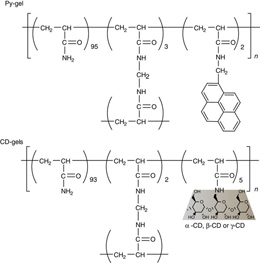Research Abstract
混合溶媒系を用いた巨視的分子認識の選択性の変換
Switching of macroscopic molecular recognition selectivity using a mixed solvent system
2012年5月15日 Nature Communications 3 : 831 doi: 10.1038/ncomms1841

分子認識に基づく巨視的集積体の形成は、幅広い材料科学分野において有望である。また、高機能材料を作製するために巨視的集積の選択性の変換がますます重要になっている。今回我々は、ピレニル(Py)部分で修飾したポリアクリルアミドゲル(Py-ゲル)とCD部分(αCD-ゲル、βCD-ゲル、γCD-ゲル)を持つゲルとを用いて、水とジメチルスルホキシドの混合溶媒における分子認識に基づく巨視的集積について示す。ゲル表面のPy部分の単量体と二量体の割合は混合溶媒の組成に依存するため、混合溶媒の組成を変えることによってPy-ゲルの選択性を変えることができる。単量体のPy部分はβCD部分と、二量体のPy部分はγCDと接着する傾向にある。
- 大阪大学 大学院理学研究科 高分子科学専攻
- 科学技術振興機構(JST)CREST
The formation of macroscopic assemblies based on molecular recognition is promising in a wide variety of fields of materials science. Switching of the selectivity of macroscopic assemblies is of increasing importance to produce highly functional materials. Here we show macroscopic assembly based on molecular recognition using polyacrylamide gel modified with pyrenyl (Py) moiety (Py-gel) and gels possessing CD moieties (αCD-gel, βCD-gel and γCD-gel) in a mixed solvent of water and dimethyl sulfoxide. Changing the composition of the mixed solvent can switch the selectivity of Py-gel, because the fractions of the monomer and dimer of the Py moieties on the gel surface depend on the mixed solvent composition. The monomer and dimer of the Py moieties prefer βCD and γCD moieties, respectively.

